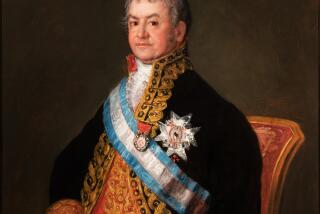Getty Buys, Shows ‘Irises’ by Van Gogh
The J. Paul Getty Museum has purchased Vincent van Gogh’s “Irises” for an undisclosed sum from Australian industrialist Alan Bond and put the painting on display Wednesday in Malibu.
Museum Director John Walsh declined to disclose the price of the painting or details of the deal, but sources close to the museum said the Getty, the world’s richest museum, paid somewhat less than the record $53.9 million that Bond paid for the painting in 1987.
The museum billed its new acquisition as “the Getty’s greatest 19th-Century painting and one of the most important works of art in the Western United States.” “Irises” will link the museum’s major French Impressionist works by such artists as Edouard Manet and Pierre-Auguste Renoir with Belgian Expressionist James Ensor’s 1888 masterpiece, “Entry of Christ Into Brussels,” said George Goldner, the Getty’s curator of paintings and drawings.
“We are not trying to make an anthology of paintings or round up all the big names. We are holding out for really great works. This is Van Gogh at his most powerful phase,” Walsh said.
The Times reported last week that the Getty was in the process of buying the painting, although officials of the Malibu museum declined to officially confirm it at the time. Wednesday’s announcement ended several months of speculation on the fate of “Irises” and allayed fears that the painting might end up in a private collection.
Bond’s purchase of the painting generated controversy in art circles because it was highly leveraged by Sotheby’s New York. The auction house loaned Bond about half of the purchase price and accepted the painting as collateral, a practice that was widely criticized for artificially inflating the art market.
When Bond bought the painting, he was one of the wealthiest men in Australia. His Bond Corp. Holdings Ltd. had assets around the world, including breweries and mineral and retail interests. But his financial empire took a dive, and in January he was reportedly more than $5 billion in debt. When Bond’s financial troubles became known, rumors began to circulate that he couldn’t pay off his loan to Sotheby’s and that “Irises” was for sale.
Bond originally took possession of the painting, but Sotheby’s later put “Irises” in secret storage--while insisting that Bond still owned the work. The auction house said in January that Bond had received “unsolicited offers” for the painting but denied that the painting was officially for sale.
Sotheby’s acknowledged on Wednesday that it acted as Bond’s agent in the sale, however.
“When we thought about potential buyers six weeks ago, the first name that came to mind was the Getty, but now that the sale is complete, I still don’t believe it,” said Diana D. Brooks, president of Sotheby’s.
Van Gogh painted “Irises” in May, 1889, at an asylum, St. Remy de Provence, which was part of the monastery of St. Paul de Mausole in Southern France. He committed himself to the asylum after a mental breakdown and lived there for a year after quarreling with his artist friend, Paul Gauguin, and cutting off part of his ear. Van Gogh took his own life in July, 1890, after he had moved to Auvers.
The painting depicts a corner of an untended garden at the asylum. A V-shaped sweep of purple irises with spiky green leaves stand against a backdrop of reddish earth and yellow-orange marigolds. The canvas exemplifies Van Gogh’s mature style and bold brushwork, but its subject matter and asymmetrical composition are unusually compelling, Goldner said.
Van Gogh apparently prized the work highly; it was one of two paintings that he selected to exhibit at the Salon des Artistes Independents in 1889.
“Irises” is in pristine condition, according to paintings conservator Andrea Rothe. “I was very excited when I saw it. It’s as fresh as if it just came out of the studio,” Rothe said. Van Gogh used inexpensive pigments that are inclined to fade, but the colors that he selected for “Irises” are more stable than those in many of his other paintings. His fortunate color choice coupled with the fact that the painting has been protected from strong light account for its fine condition, Rothe said.
Walsh explained that he and curators typically present proposed acquisitions to the acquisitions committee of the board of trustees. If the committee agrees, the work is then presented to the full board for approval.
“Irises” was in such excellent condition that, for the first time, Rothe joined Walsh and Goldner in presenting the painting to the board. Rothe was reportedly so passionate and eloquent in his advocacy that the trustees applauded his presentation.
Art world reaction to the Getty purchase was strongly positive on Wednesday afternoon. “The Getty is a major institution, and it is wonderful to have (the painting) there and to have it end up in this country,” said Andre Emmerich of the Andre Emmerich Gallery in New York.
Said New York art dealer Richard L. Feigen: “I’m delighted that a very beautiful work of art has found a home and is no longer being bruted around and bounced from pillar to pillar . . . from New York to Perth to Malibu. I am delighted it has come to rest in a great museum.”
John Whitney Payson, who owned the work before Bond, also expressed delight that “Irises” will be on public view in the United States.
“I couldn’t be happier,” he said. “The news leaves me euphoric. If I could have chosen where I wanted the painting to go back in 1987, it would have been the Getty Museum.”
Payson had put “Irises” on long-term loan to Westbrook College in Portland, Me., after inheriting the work from his mother, philanthropist Joan Whitney Payson, who bought it in 1947 for about $80,000. However, after Van Gogh’s “Sunflowers” sold for a record $39.9 million on March 31, 1987, Payson decided to sell “Irises” to fund a family foundation.
Emmerich said his “hunch as an art dealer” was that Getty paid a price near the amount paid by Bond in 1987. But others in the field believed that it was more likely Getty was able to pay a lower price and obtain a true bargain.
“The Getty is the only museum in the country who can afford to buy that painting,” said Ben Horowitz, chairman of the appraisals committee of the Los Angeles Art Dealers Assn. “I’m sure they are going to strike a hard bargain, but whether they got a bargain, I don’t know.”
(The J. Paul Getty Trust, which operates the museum, has an endowment in excess of $3 billion.)
News of the purchase excited the entire museum staff, from secretaries and security guards to curators and administrators, Goldner said. The heady atmosphere seemed to be contagious at the museum on Wednesday as startled visitors discovered “Irises.”
“Imagine that,” said one man who did a double-take as he rounded a corner and saw the celebrated painting hanging in a gallery.
As word of the acquisition spread, the museum received a burst of calls for the parking reservations required of most museum visitors. By 11 a.m., the office was taking 100 calls per hour instead of the typical 50 to 75, according to press officer Lori Starr. “By tomorrow, I’m afraid people will get busy signals,” Starr said.
More to Read
The biggest entertainment stories
Get our big stories about Hollywood, film, television, music, arts, culture and more right in your inbox as soon as they publish.
You may occasionally receive promotional content from the Los Angeles Times.










